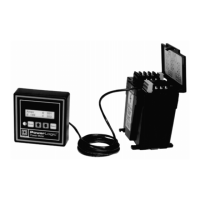Power Meter Bulletin No. 3020IM9503R6/98
Chapter 8—Metering Capabilities December 1998
64 1998 Square D All Rights Reserved
If the interval is between 16 and 60 minutes, the demand calculation updates
every 60 seconds on a sliding window basis. The present demand value
displayed by the power meter is the value for the last completed interval.
Block Interval Demand with Subinterval Option (PM-650 Only)
When using POWERLOGIC software, you must select both a block interval
and a subinterval length. The default subinterval length is 0 minutes. At this
default setting, the sliding block interval calculation described above is
performed. If you set the subinterval to the value of the block interval, a fixed
block calculation is performed and the demand calculation is updated every
interval. If you set the subinterval to a value other than 0 or the block interval
value, the power meter performs a rolling block demand calculation and
updates the demand calculation at every subinterval.
Synch to Comms (PM-650 Only)
If you set the demand to 0 using POWERLOGIC software, the synch to
comms demand calculation is used. See Appendix E for more information.
Predicted Demand (PM-650 Only)
Predicted demand is the average rate of power use during the most recent
one-minute interval. It is called predicted demand because the best estimate
of future power use is the power used in the most recent past.
The power meter calculates predicted demand for kW, kVAr, and kVA,
updating the readings every 15 seconds. The predicted demand value does
not predict the outcome of the present demand interval. Rather, since it
represents only the most recent 1 minute interval, it is more responsive to
recent increases or decreases in power than the present demand calculation.
Peak Demand
The power meter maintains, in nonvolatile memory, a “peak demand” for
each average demand current and average demand power value. It also stores
the date and time of each peak demand. In addition to the peak demand, the
power meter stores the coinciding average (demand) 3-phase power factor.
The average 3-phase power factor is defined as “demand kW/demand kVA”
for the peak demand interval.
Peak demand values can be reset using the power meter display, or over the
communications link using POWERLOGIC application software. To reset
peak demand values using the power meter display, see Performing Resets
on page 54.

